The average American eats 1,996 pounds (905 kg) of food per year. It adds up quickly if you consider the average person eats three meals a day. Times that by 365 days a year, and you get over 1000 meals – or a lot of food.
That’s almost one ton of food or the weight of a 1979 Volkswagen Beetle, Giraffe, or Baby Humpback Whale. [1]
That’s also a heck of a lot of loo roll! (Americans use an average of 141 toilet rolls per person a year.) [2]
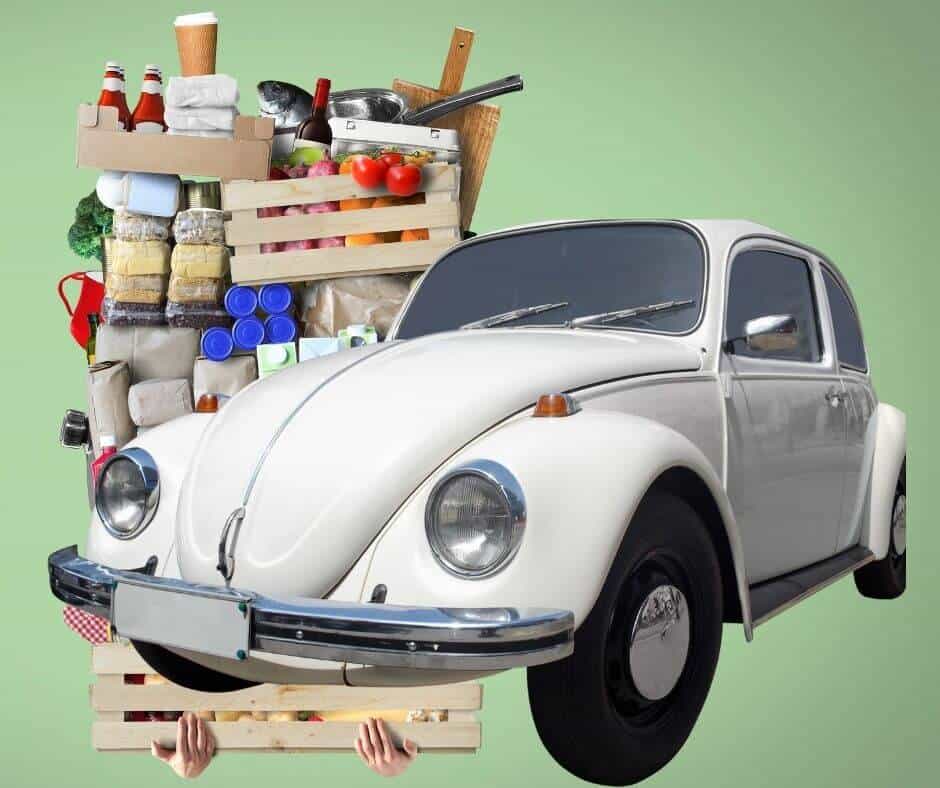
Keep in mind that the average food consumption per person per year varies around the world based on different cultures, local dishes, and diets. But for the purposes of this article, I’ll focus on an American diet.
Average Calories Consumed Per Day/ Per Year
Specific diets vary by individual from about 1,600 to 3,000 calories per day. The USDA and Health.gov estimate that on average, Americans eat about 2,700 calories a day. That adds up to 985,500 calories a year! [3]
Considering the recommended daily calorie intake which is 2,000 for women and 2,500 for men then the USDA estimation of 2,700 calories a day is just above the recommended daily calorie intake.
Read Also: 10 Best Websites to Find Food Industry Statistics And Data
How Much Fast Food Do Americans Eat Each Year?

According to the National Center for Health Statistics, American adults consumed 11.3 percent of their total daily calories in fast food. Every day, about 36.6 percent of Americans eat fast food, according to the same study. [4]
The majority of those consuming fast food are aged 20 to 39. But, it’s also the majority of children. Every day one in three kids eats fast food. This adds up to a lot of money spent on fast food each year. Americans spend about 10 percent of their disposable income (about $1,200 a year) on fast food every year. [5], [6]
Who Ate All the Pies?
Breakdown By Food Types

First off, we consume most of our food weight in dairy products like milk, yogurt, cheese, and ice cream. Americans eat 630 pounds (286 kg) of dairy on average a year. And of that, 31 pounds (14 kg) alone is cheese.
The second-largest portion of the American diet in weight is veggies. Americans eat about 415 pounds (188 kg) of vegetables a year.
For fruits, on the other hand, the average person eats 273 pounds (123 kg) of fruit a year. However, that’s mostly in water weight since fruits contain high amounts of water.
The next largest portion of the diet is meats and poultry (think chicken, turkey, pork, and beef). Americans consume about 185 pounds (83 kg) of meat a year on average.
Finally, wheat and grains constitute the smallest weight of the American diet, coming in at an average of 197 pounds (89 kg) per year.
However, besides your basic food groups, Americans also consume a high amount of sweeteners, fats, and oil. On average, it’s 141 pounds (64 kg) of sweeteners, 42 pounds (19 kg) of corn syrup, and 85 pounds (38 kg) of fats.
10 Foods Americans Eat A Lot of Each Year
As already mentioned, Americans eat 31 pounds of cheese, 141 pounds of sweeteners, and 85 pounds of fat a year. But what does that look like in actual foods?
1. Hamburgers
The average American eats three burgers a week, which adds up to 50 billion total across the U.S. We love hamburgers so much, that they are about 40 percent of all sandwiches sold nationally. [7]
2. French Fries
Can you imagine an eating competition to eat 29 pounds (13 kg) of French fries?
Well, that’s what the average American eats in a year. That adds up quickly; fast-food restaurants sell about 2 million tons of French fries per year in America. And, it makes sense that McDonald’s buys 7 percent of the world’s potato crops and 3.4 billion pounds of U.S. potatoes annually. [8]
3. Hot Dogs
Hot dogs are a summer treat for many Americans, which is why they are consumed almost entirely between Memorial Day and Labor Day. And the average person will have 21 hot dogs before the summer’s over. [9]The Fourth of July, which obviously isn’t complete without a hot dog, averages about 150 million hot dogs eaten each year.
4. Chicken Nuggets
About 4.8 billion McNuggets are sold every year, but that only comes down to 15 McNuggets per person. I don’t know about you, but my kids had about 100 chicken nuggets last week, so this number might actually be below.
5. Bacon
We love our bacon. But did you know that Americans eat on average 18 pounds (8 kg) of bacon a year, each? That adds up to about 5.7 billion pounds of bacon each year!
6. Donuts
Americans eat an average of 63 donuts a year per person. This makes sense because the U.S. produces about 350,000 donuts per week! And if you live in Massachusetts you may be doing your part to bring that average up. Boston has the most donut shops per capita, with one shop for about every 2,500 people.
7. Chips
Chips do not weigh very much; most chip bags seem like more air than the product. So the fact that Americans eat an average of 4 pounds (1.8 kg) of chips per year is a lot more than it sounds.
For perspective, potato chips is a 7 billion dollar industry annually in the US. And on Superbowl Sunday, we eat about 12 million pounds of potato chips. The most popular flavors are Sour Cream and Onion and Barbecue.
8. Oreos
Naturally, milk’s favorite cookie makes the list. We eat about 22 Oreos a year in America. (Again, that number actually sounds low to me… but maybe I just love Oreos more than average!) Since Oreos opened in 1912, they have sold almost 500 billion cookies – enough cookies to circle around the Earth 381 times! [10]
9. Ice Cream
Okay on this one I know I eat more than the average. It’s estimated that Americans eat 47 pints (27 liters) a year per person, or 15 billion pints (8.5 liters) total across the U.S.I love ice cream, and by the amount we eat every year, it’s clearly not just a summer treat. Rain, snow, or shine I’ll happily sit down to a bowl of ice cream and clearly, most Americans will as well, in order to eat 47 pints a year.
10. Pizza
Finally, pizza. I’d be surprised if this one didn’t make the list. Americans eat about 100 acres (0.4 square kilometers) of pizza a day, which divides up to 350 slices a second. And 93 percent of Americans eat at least one piece of pizza a month.
Read Also: How Safe Is To Eat Pizza That Was Left Out Overnight In The Box?
How Much Money Do Americans Spend On Food Each Year?
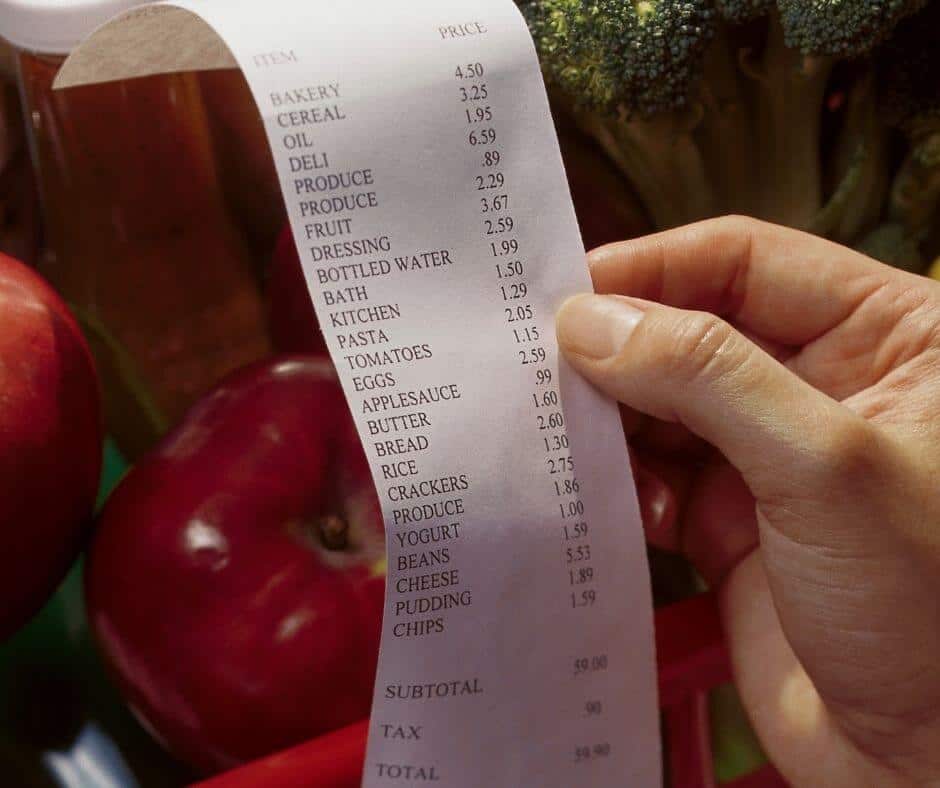
Americans typically budget more money for food than any other part of their monthly budget. [11] The National Bureau of Labor Statistics estimates that Americans spend over $7,700 a year on groceries and restaurants. [12]
For an individual, they estimate it costs about $4,425 a year for their normal groceries and eating out. However, families can share the costs of food, and a family of four spends on average about $10,995 on food a year.
Read Also: Here Is How Much I Spent On 6 Month Food Supply for a Family of 4 (The Figure Might Surprise You)
How Much Time Do People Spend Eating a Year?

In a study by USDA from a few years ago, they found that on the average day, an American only spends 67 minutes eating without distractions. And with increasing screen time, trends show that number decreasing. [13]
However, the study found that Americans also spent an additional 23.5 minutes eating while multitasking. So, that’s a total of 90.5 minutes a day eating. In one year, that adds up to over 33,000 minutes, over 550 hours, or almost 23 days spent eating.
How Much Does A Person Drink a Year?

Studies show that Americans drink an average of 44 gallons (200 liters) of soda per year, and about 58 gallons (263 liters) of water. For soda, that’s about 14 billion gallons (63 billion liters) consumed a year across the US. [14]
That may sound like a lot, but that only averages to about 2.5 cups a day which is not enough to prevent dehydration. And 58 gallons is actually less water than many mid-sized fish tanks hold.
According to the Mayo Clinic, you should drink 15.5 cups a day for men, and 11.5 cups a day for women. However, the actual amount of water you need depends on your exercise level, environment, and health. [15]
If Americans drank the recommended amount of water, then they would drink anywhere from 260 to 350 gallons (1181-1591 liters) of water a year. From that perspective, the 58 gallons (263 liters) we actually drink seem like barely a drop in the bucket.
How Much Food Does the Average Person Consume in a Lifetime?

Evidently, we generally eat between 3.5 to 5.5 pounds (1.5-2.5 kg) of food a day and, if we eat healthy foods, roughly 4 pounds (1.8 kg) will fill us up. As mentioned above, last year, the average Westerner ate 1,996 lbs (905 kg) over the year…
Suppose we assume the average lifespan is around 79 years of age and that each year is roughly 365.25 days (remembering leap years) and that we’re supposed to have an average of 1800 energy calories a day. In that case, different countries will differ.
For instance, the USA has an average of 2,700 calories a day, whereas some African states such as Eritrea in western Africa consume only 1,590!
So, if we work out that women need 2,000 calories a day and men 2,500, then the daily average for a human is 2,250 calories, which makes it 64,923,187 calories consumed in the average human’s lifetime – whoa.
It is estimated that the average person eats about 35-40 tons of food in a lifetime. To give you a better visual understanding of that figure, a fully loaded 18-wheeler semi-truck with a trailer weighs about 40 tons. That’s not so good, people!
Time to cut back…
Read Also: 33 Foods That Help You Feel Full And Eat Less
Heavy Stuff!
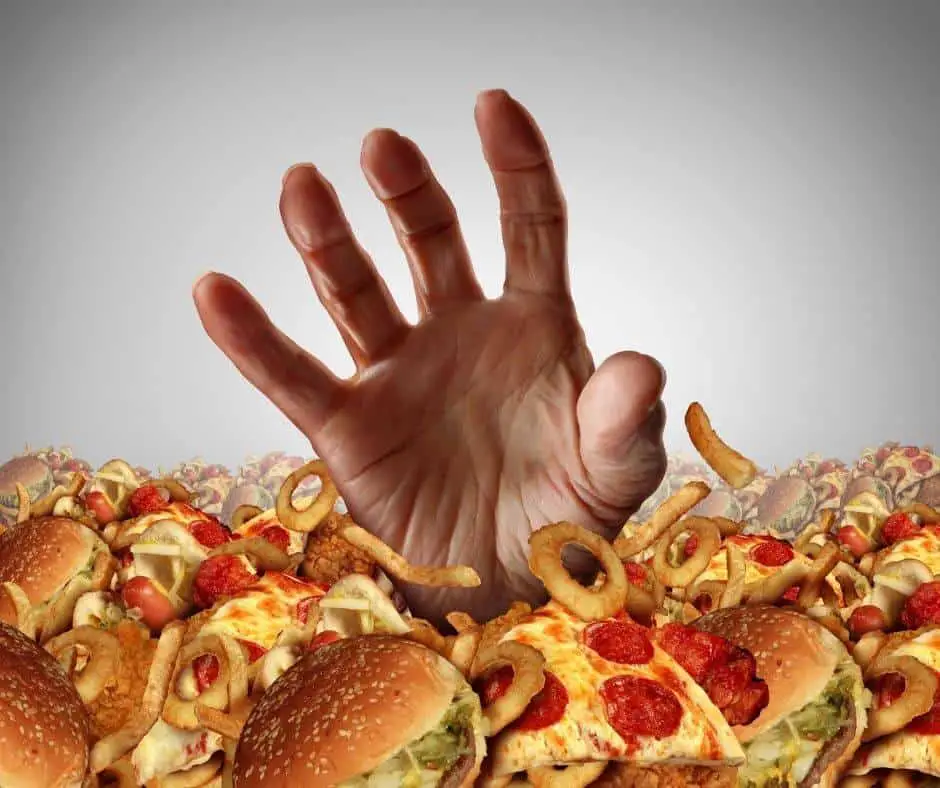
It turns out that although poor diets are a major factor for 1 in 5 deaths around the world, we are still living longer.
Because it appears that although humans are living for longer – in the US the average death, regardless of our poor diets, tends to be 78.54 years, we are spending more years in ill health due to our poor diet choices.
Diet is, in fact, the second-highest risk factor for early death after smoking.
So, it’s not so much about how much we’re cramming into our faces, but what we’re eating – after all, if we’re eating healthy and nutritious food choices, we should be filling ourselves up with nutritious good-for-us foods which, unlike processed junk foods, means we won’t want so much of it at each sitting.
Bon Appetit!
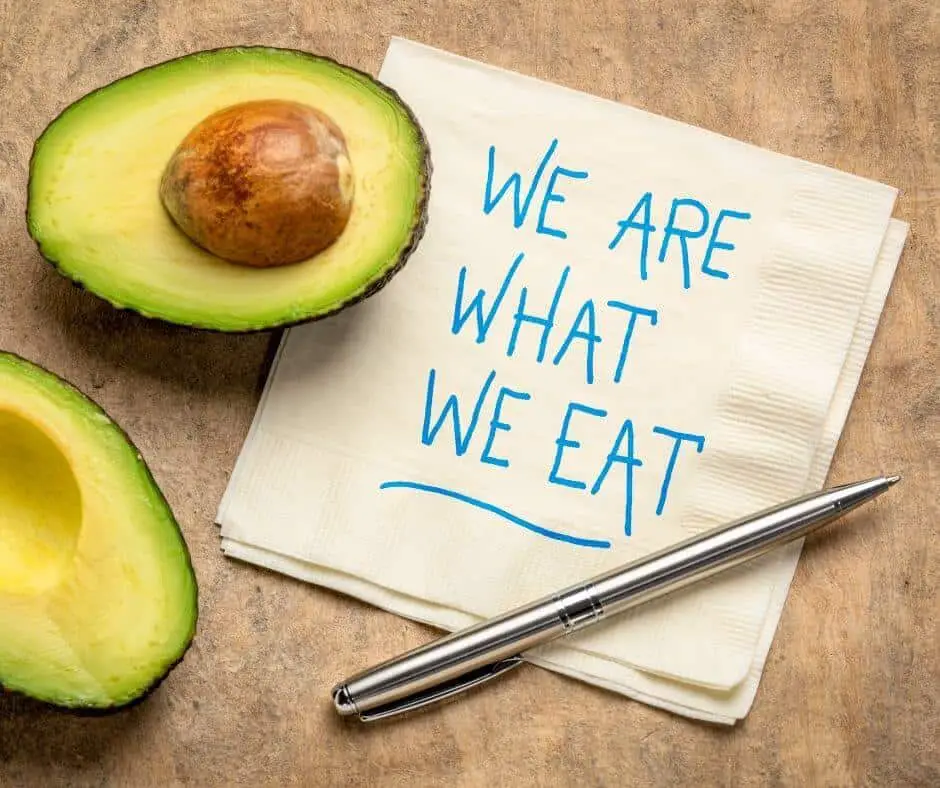
The human relationship with food is complex.
Even since the days of Plato, who believed humans have to make choices like a charioteer of the soul commanding two horses – one noble and one wicked.
So the next time your hand reaches for that bacon sandwich oozing with tomato sauce, should it really be veering towards the salad instead?
We obviously have to eat to survive and for our bodies to maintain a healthy balance of nutrition and sustenance but getting the balance right isn’t always easy.
Because supposedly we are what we eat…
Food seems to constitute our very being – it affects our health, serves up our sensory delights, and makes us human – what other mammal fusses over food in the same way as humans?
Did you know that the average grocery shop stocks roughly 32,000 different products that we humans love to devour, and we take an average of 2% of our lives checking out those grocery aisles to see what we can consume to ensure our 35 tons of food is completed by the end of our lives?
As humans, we intensively manage our sustenance sources and shape them to feed our needs and desires, which ultimately affect the environment on a global scale.
Did you know that roughly four cans of Spam are opened every four seconds?
And that 400 quarter-pound hamburgers can be made from one beef carcass?Nope? Not many of us do…
Strawberry Fields
It may be the name of a popular song, but if we humans have too much of a good thing, then all this excessive food eating can’t be doing us much good…
Sadly for us average humans, eating isn’t as simple as just refueling a car.
We don’t just fill ourselves up when the indicator nudges towards empty.
And we never treat ourselves by filling up with a car with fuel.
In fact, our obsession with eating means that, on average, a human also eats roughly 2.8 unhealthy snacks in a single day.
So what starts out as a biological need ends up becoming far more complex and messier, especially when you throw in emotions, memories, ideas, and rituals into the mix.
Our relationship with food takes on lots of different meanings, such as punishment, appeasement, celebration, obligation, and reward.
It depends on our moods, the time of day, and who we’re with – which can lead to our overeating, undereating, or making bad food choices.
Okay – so we all know that stuffing our faces with bad food choices is bad for us, but did you know that:
- Skipping a healthy breakfast is bad for us? Missing a meal doesn’t mean it’s healthy…
- And that eating too many calories late at night is linked to obesity? Remember the old saying, ‘Eat your breakfast like a king, eat lunch like a prince, and eat your dinner like a pauper.’
- Juicing isn’t as good for you as some health pundits maintain because when you are eating solid, nutritious, and filling foods, chemical reactions happen in your body that leave you feeling satiated and full longer that keeps you from feeling peckish or crave for food for hours.
- Watching television or doing other multi-tasking things while you are eating isn’t a good idea as you’re often distracted about how much you’re eating!
Come on, You Foodies
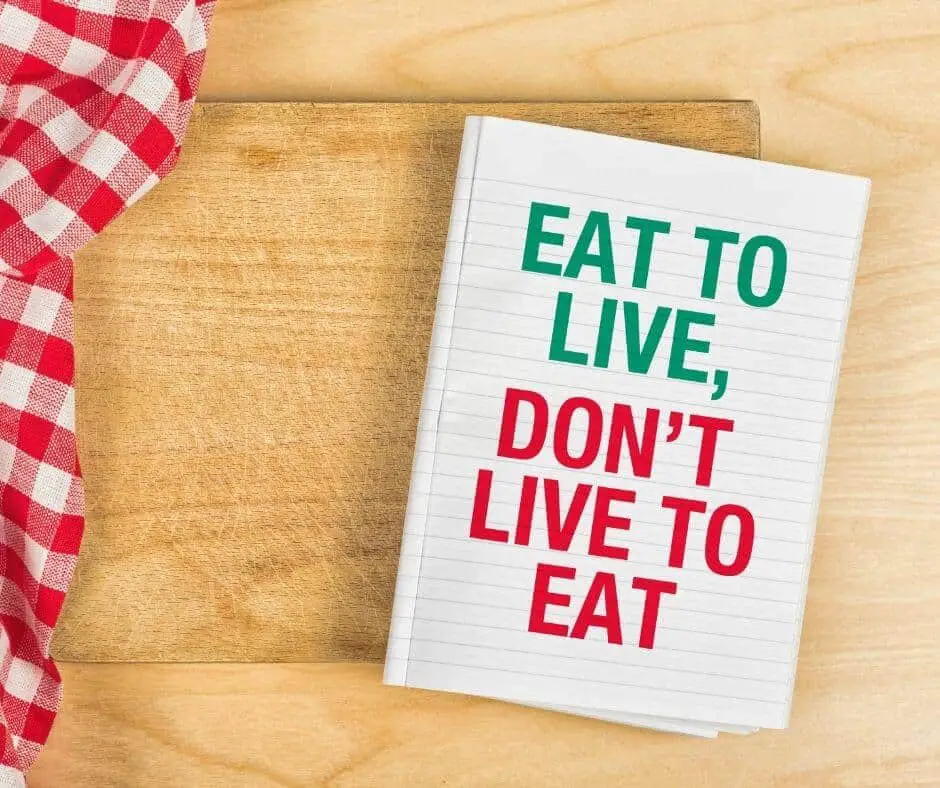
Have you noticed that when you try and cut back on your food intake by dieting or eating more sensibly, there always seems to be more adverts, and every type of ‘bad’ food choice which you usually love appears to be screaming at you in temptation from everywhere?
But, you know that stuffing your plate from edge to edge, and stacking the food up high, is not helpful. Remember, it’s always your choice – no one is forcing you to pile up.
Eating when you are actually not that hungry, could be because you are depressed or worried, can give you a lot of problems in the long run. So, avoid comforting yourself with food when you feel like this.
Eating way too much and having no regard for portion sizes can have quite a bag consequences such as diabetes, hypertension, high cholesterol, and obesity.
In technical terms, overeating or binging means eating an amount of food that is ‘inappropriately sizeable for an item of given energy expenditure.’ Try to go without eating between meals. If you feel peckish, don’t reach for snacks or food but try drinking water first, and if you still feel hungry, try something healthy like fruit or nuts.
Remember, as Benjamin Franklin said: ‘One should eat to live, not live to eat.’
So, next time you reach for that butty, think, do you really want a lifetime of obesity and ill health, or would you prefer to live a long, healthy, and happy life?
Read Also: Stock Up On These 14 Nutritious Long Shelf Life Food Instead
Food Fun

Food can be exciting, and we should try and enjoy it. It doesn’t have to be a matter of good and bad food.
Moderation and a little forward planning are the way ahead for us all.
We shouldn’t always believe what the huge food industry moguls tell us either – remember they want us to buy the food products that they put into the grocery aisles, so they dangle temptation with over-processed and unhealthy food options before us all the time.
So, next time you’re in the supermarket, you can still have lots of yummy food choices, but just ensure your food choices are wise and avoid the ultra-processed-food sections.
Make sure you get lots of plant-based products, and you can still have beef and bacon, but in moderation, variation and diversity is the key, and try and aim for roughly 30 different types of plants in a week, including nuts and seeds. Fasting one day a week could work for you…
So, throw away old ideas and work out what works best for you as we’re all unique.
If not, you’d better stock up on loo roll.
Read Also: Exciting New Food Trend – Have You Tried These Ethnic Foods?
